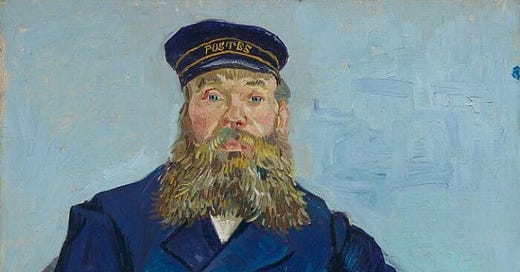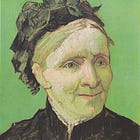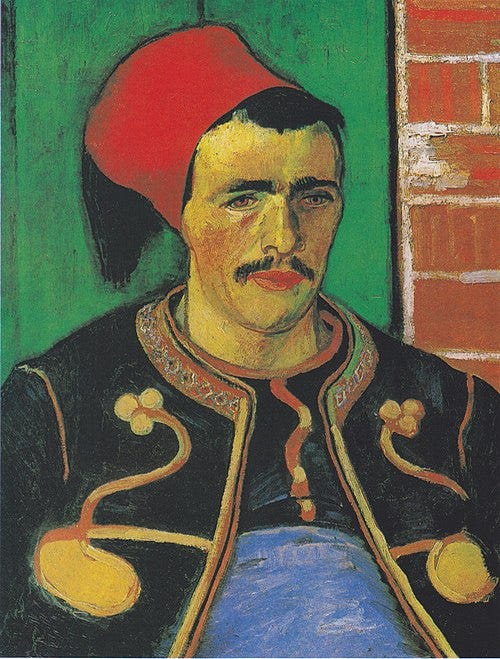Friends, I think this is it. The last installment in my Van Gogh obsession series. Read the rest of my ramblings at the links below. Thanks so much for following along and showing enthusiasm for my weirdness.
It’s on to Georgia O’Keefe next I think. And then maybe James McNeill Whistler, whose biography I got from the library because I mistook him for John Singer Sargent, which tells you how much I know about either guy.
Read all the way through for a blurb from my novel-in-stories, SEX OF THE MIDWEST, coming October 14 from Galiot Press!
Picture a painting by Van Gogh. What do you see? Sunflowers? Irises? A bedroom? A starry night sky with swirling stars? A haunting self-portrait?
What you probably did not picture was a portrait of someone who is not Van Gogh himself. You probably did not picture people except as distant figures in a field. The paintings Van Gogh is most remembered for are generally not of people1, even though it was what he most aspired to do.
Van Gogh thought of himself first and foremost as a portrait artist. He wanted his brother, Theo, to be the landscape painter. Vincent was happy to cede that to Theo. Vincent, on the other hand, would be the portraitist to the peasants.
The problem was that Van Gogh could mostly only paint what was in front of him. That meant he needed models. Which meant he needed money to pay models. Which meant he spent a lot of time begging his brother for money to pay models.
But most importantly, it meant that Van Gogh needed to be able to convince people to be his models. He needed good, or at least passable, interactional skills that it appears he might not have had. By and large, people didn’t seem to want to model for Van Gogh, money or no money.
With his models, Van Gogh was bossy and demanding and probably more than a little weird. Given his track record with women2, I doubt he was a guy who would have made them feel particularly safe, which might be why he ended up painting men like the postmaster in Arles, Joseph Roulin, and the retired soldier, Lieutenant Milliet, often simply called the Zouave.
Whenever Van Gogh moved to a new place, there was an initial period when he was rich in models, before he alienated everyone in the community. Then as the people got to know him, his supply inevitably dried up. This was a man who almost everywhere he went accrued a group of children or young men who followed him around mocking him. Sometimes they actually threw things at him.3 Popular Van Gogh was not. His life in many ways was a long and endless search for models, a battle he mostly failed to win.
I’ve always thought of myself as a fiction writer, so in my late forties, I was surprised to find myself the author of three nonfiction books and zero books of fiction.
I had never stopped writing fiction. I’d had success publishing short stories and flash fiction. I’d written several novels (don’t ask how many…never ask a writer how many failed novels they’ve written). I’d just never made that leap into a published, book-length work of fiction and it made me begin to wonder—maybe I’m not a fiction writer after all?
Maybe, I thought, I should stop directing my energy into stories. Time to write is a finite resource, after all. This is especially true if you’re working a full-time job that is not writing, which I do. If my nonfiction seemed to do better than my fiction, shouldn’t I work on that in the limited hours and days I had available.
Drawing people is objectively hard. Much harder than drawing say a tree or a building. This is because we are highly attuned to faces and bodies. You can get many details of a building wrong and it still looks like an acceptable version of a building. Mess up one tiny detail of a face and it becomes outright disturbing. Wrong. We spend so much of our lives looking at other faces that we have become experts of the highest degree.
That doesn’t even take into account the extra difficulty of not just getting the face right, but also somehow conveying something about that living human being through the medium of paint. This is, of course, why we are fascinated by paintings like the Mona Lisa or Girl with a Pearl Earring. The people in those paintings speak to us. They are alive. How do you do that with smears of paint on a canvas?
Given how hard portrait painting is, why was Van Gogh so obsessed with it? He’s painting at the same period as many of the Impressionists who were having great success with water lilies and gardens. Why this obsessive quest for models?
Sadly, I think that part of the answer is simply that he was lonely. As I wrote before, Van Gogh felt exiled from his family. He craved community. The closest he came was with one of his models, whom he wanted to marry. I think it’s probably true that he wanted to paint people because he feared it was the only way he could be around people.
But also, there was something about painting people that appealed to Van Gogh. He was an avid reader and often of fiction. He read Charles Dickens and George Eliot and Victor Hugo and Emile Zola. He smoked tobacco because Dickens once said it was a prophylactic against suicide. His paintings of empty chairs (his and Gauguin’s) was inspired by an illustration of Dickens’ empty chair after he died.
In other words, Van Gogh liked stories. A part of him wanted to tell stories with his art. What better way to do that than with portraits?
I find it generally easier to write nonfiction than I do fiction, which might be more evidence that nonfiction is where my real strength as a writer lies. I’m not sure why nonfiction feels easier, except the vague sense that when I sit down to write it, I know exactly who I’m writing to. Namely, you, dear reader. Nonfiction feels like a conversation in a way that fiction does not.
With nonfiction, I am saying a thing and the point is to get the thing said. What the unholy fuck is the point of fiction? To entertain? To transcend? To tell a truth? All of the above?
On top of that, creating characters is probably just as hard as painting people. A portrait creates a real person from the stuff of pigment and brush. All a writer has are black lines and curves on a field of white. Letters and words and yet, the characters become real. Perhaps my desire to write fiction is every bit as misguided as Van Gogh’s obsession with portraits.
When I read Van Gogh’s biography, I came away with a certain narrative about Van Gogh and his portrait obsession. He wanted desperately to paint people even though it probably wasn’t his strength. It was a mistake, I thought, this endless pursuit of models. He could have spent more time with irises and sunflowers, which, let’s be honest, he makes every bit as interesting as a human face.
But what do I really know about what Van Gogh should or shouldn’t have been painting? I’m not an art historian. I’m just a writer with a Van Gogh obsession. Also, I’ve already admitted that I don’t particularly believe in talent the way people generally talk about it, so it wouldn’t make any sense to say Van Gogh’s natural strength was toward landscape or still life and not portraits. Maybe if he’d actually got those models and the opportunity to work at it, we’d be talking about Van Gogh as the best portrait artist of all time. Who can say?
Maybe that I’ve published three nonfiction books means nothing. Maybe it’s much more about luck and the publishing market than it is about my inherent talent or skills.
Maybe in the end, it’s all the same. I’ve written pieces that I’m still not sure are fiction or nonfiction. I often wonder if we should think of memoir as just another fiction genre. Every story is crafted, even the “true” ones. Everything is true-ish in the end, isn’t it? Which is to say, everything is more true for being a little less so.
Thanks to all my new subscribers and everyone who’s stuck with me on this endless Van Gogh journey! And to the folks who’ve been hitting that Tip Jar button above. So appreciated!
This week I met with the folks at and some lovely people from Midas PR about marketing and publicity for SEX OF THE MIDWEST, which is always very exciting. Pub date is October 14th! Stay tuned for pre-order announcements and in the meantime as a teaser, here’s a blurb from , MacArthur genius award winner, author of HEAVY, and the inventor of a very weird but delicious dish made with ramen noodles. Kiese made my heart sore by comparing the stories to ’s amazing book, THE SECRET LIVES OF CHURCH LADIES, which, yes, was one of the books that made these stories seem possible. If you haven’t read the book, go do that right now.
“I've not been this undone and awed by a short story collection since The Secret Lives of Church Ladies by Deesha Philyaw. Robyn Ryle proves that narrative fearlessness, ambition and radical play reach their highest resonance when foundationed on an ungodly talent and stunning skill. It's impossible to say what's more soul-snatching here: the premises or the writing. It's hard to deliver on what feels like an impossible book to imagine. It's harder to make the writing of that impossible book seem easy, or even inevitable. Robyn Ryle does both. The short story and literary sex are somewhere sweating and smiling, so thankful that they are alive, and in union, again.” —Kiese Laymon
The exception might be The Potato Eaters, but I really don’t like that painting, so.
Okay, this could also be a whole other post, but I probably won’t write it. Needless to say, Van Gogh did not have much success with women, unless you count sex workers and sometimes even they got sick of him. He fell in love with his cousin, Kee Voss, and then became totally obsessed with her, even though it appears he didn’t know her very well, if at all. When he proposed to her she said, “Never, no. Never.” He became obsessed with that, too.
In fact, some theories suggest that it was one of these boys who actually killed Van Gogh and that it was not a suicide. I’m convinced. I don’t think Van Gogh killed himself. He’d been out painting that day and as long as dude could paint, he had no intention of dying.
















I think it’s rare to hear ppl trained as academics exploring these questions but I’m definitely down for it too. Thanks for sharing all of this.
Okay, you made me go searching for info re Van Gogh not committing suicide. (Yay, I'm glad to hear it!) I found an article called NCIS: Provence (Vanity Fair, 2014) on the topic, along with the nearly 1,000 page book. I elected to read the article and have downloaded it. Thank you so much for your deep dive into Van Gogh. I love it.